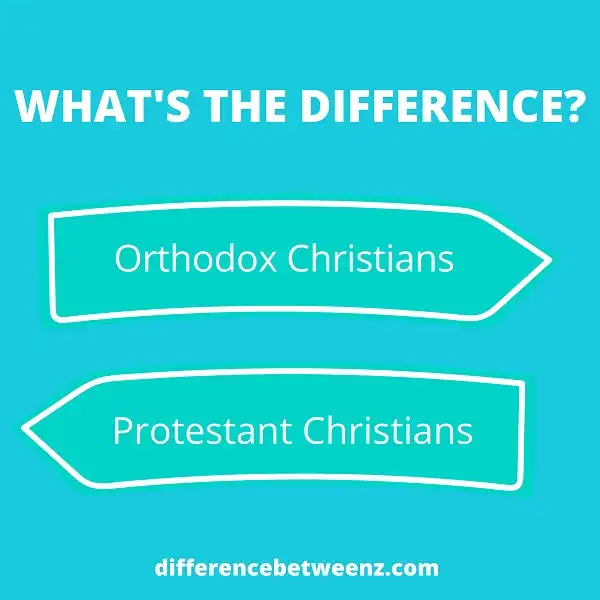The distinctions between Orthodox and Protestant Christianity encompass a broad spectrum of theological, liturgical, and historical dimensions. Both branches of Christianity are rich in tradition and belief yet diverge significantly in doctrine, practices, and ecclesiastical governance. This article endeavors to elucidate these differences in a comprehensive manner, providing readers with an insightful perspective on the intricacies of each denomination.
Theological Differences
At the heart of the divide between Orthodox and Protestant Christianity lies differing theological perspectives. Orthodox Christianity embodies a rich doctrinal heritage, deeply rooted in the early church’s teachings, and emphasizes the sacraments, particularly the Eucharist, as pivotal to spiritual life. The Orthodox believe in the concept of ‘Theosis,’ or deification, whereby believers are called to achieve unity with God through participation in divine grace. This notion indicates an ongoing transformative process that allows individuals to mirror God’s divine nature.
On the other hand, Protestant theology emerged as a reaction to what its proponents viewed as the excesses and errors of the Catholic Church. Rooted in the Reformation of the 16th century, it underscores the principles of *sola scriptura* (scripture alone) and *sola fide* (faith alone). Protestants often emphasize the sufficiency of scripture as the sole authority in matters of faith and practice, thereby minimizing the role of tradition and sacraments compared to their Orthodox counterparts.
This theological schism extends into Christology—the study of the nature of Christ. While both traditions affirm the dual nature of Christ—fully divine and fully human—the Orthodox Church expresses this through the Chalcedonian Definition and the Eastern Orthodox emphasis on the mysteries of faith, whereas many Protestant denominations may adopt a more analytical approach, emphasizing justification and salvific grace for believers primarily through faith.
Worship Practices
The worship practices in Orthodox and Protestant churches further illustrate their theological disparities. Orthodox worship is characterized by its high liturgical formality, including the Divine Liturgy, which is often celebrated in ancient languages such as Greek or Church Slavonic. The use of icons, incense, and elaborate vestments creates an ambiance that seeks to transcend the temporal and transport worshippers into the sacred realm. The sacraments hold paramount importance, and believers partake in the Eucharist as a means of experiencing communion with Christ and the heavenly realm.
In contrast, Protestant worship is marked by its diversity in expression and considerable variations among different denominations. Many Protestant churches prioritize preaching and teaching as foundational elements of their worship services. Hymns and contemporary music styles are prevalent, often complemented by personal testimonies and congregational participation. The emphasis on the sermon as a pivotal moment of worship underscores the Protestant belief in the power of the Word of God to effect change in individuals’ lives.
While some Protestant traditions, particularly liturgical ones like Anglicanism and Lutheranism, retain ritualistic elements, others adopt a more informal approach, fostering an environment of spontaneity and personal engagement with the divine. The communion service, or the Lord’s Supper, is often symbolic in many Protestant settings, representing collective remembrance of Christ’s sacrifice rather than the mystical transformation believed in Orthodox practice.
Historical Context
Understanding the historical trajectories of Orthodox and Protestant Christianity provides crucial insights into their current manifestations. Orthodox Christianity, divided broadly into Eastern Roman (Byzantine) and Oriental traditions, traces its roots back to the early Christian articulations within the Roman Empire. The Great Schism of 1054 formalized the separation between Eastern Orthodoxy and Roman Catholicism, leading to significant theological and political ramifications. The Orthodox Church preserved key elements of early Christianity and maintained a continuous apostolic succession, emphasizing the authority of ecumenical councils and traditions.
Protestant Christianity emerged from a distinct historical milieu during the Reformation, spearheaded by figures like Martin Luther, John Calvin, and Huldrych Zwingli. The movement sought to reform the perceived doctrinal and moral failings of the Catholic Church, catalyzing the establishment of various denominations. The translation of the Bible into vernacular languages made scripture accessible, promoting individual interpretation and faith over institutional authority.
This historical rift has fostered an enduring dynamic of inter-denominational dialogue and debate. While Orthodox Christians historically emphasized conciliar governance, viewing the patriarchy and bishops as the custodians of faith, Protestants often gravitate towards congregational governance, reflecting their commitment to individual and collective interpretation of scripture.
Conclusion
In summation, the differences between Orthodox and Protestant Christianity are profound yet serve to enrich the Christian tradition as a whole. Each tradition possesses a unique lens through which to understand God, worship, and community life. The theological constructs, worship practices, and historical contexts shape not only the theological frameworks of these branches but also the lived experiences of their adherents. Engaging with these distinctions may encourage a deeper appreciation for the diverse expressions of faith that characterize the broader Christian landscape.



